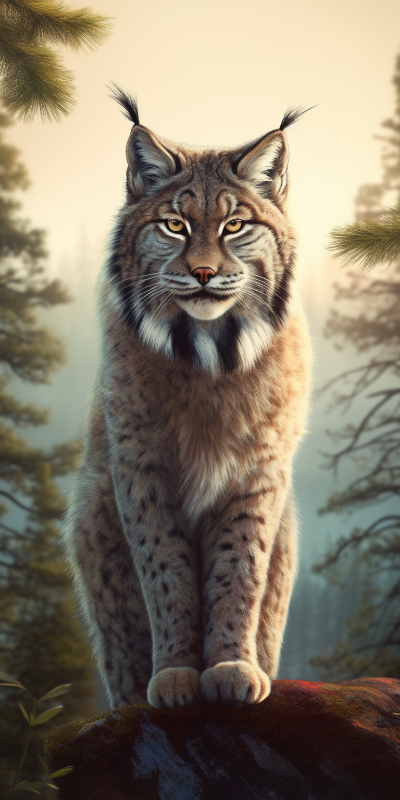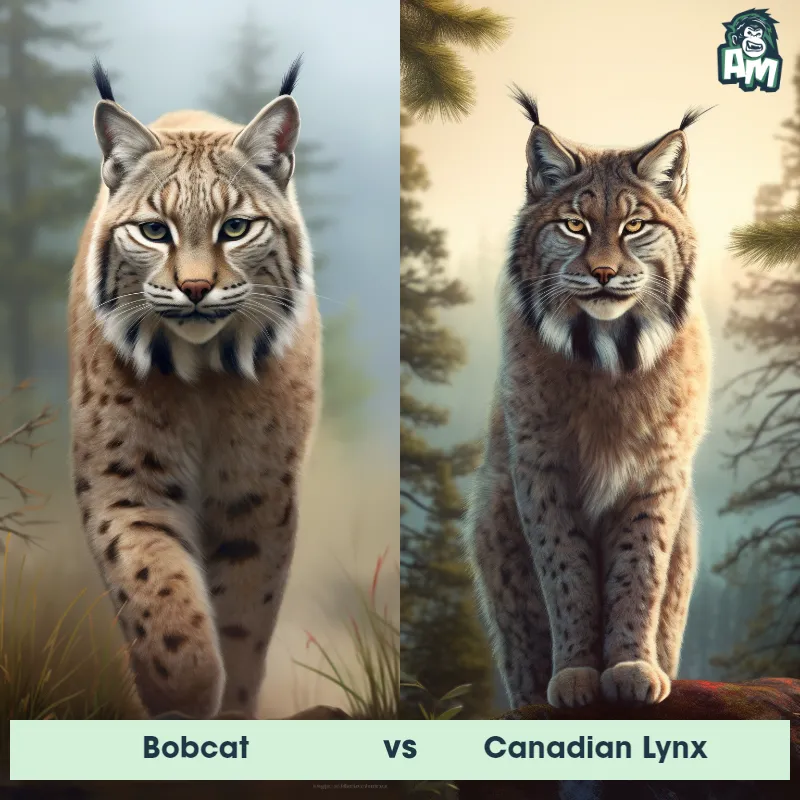The Canadian Lynx
The Canadian Lynx, also known as Lynx canadensis, is a medium-sized wild cat native to North America. It has a robust build with a short tail and long legs adapted for hunting in snow-covered terrain. This lynx species is characterized by its dense, long fur that varies in color from gray to reddish-brown. Their large tufted ears and prominent whiskers help them navigate and detect prey. These solitary animals primarily feed on snowshoe hares and have specialized paws to prevent sinking in deep snow.

| Canadian Lynx | |
|---|---|
| Size | 18-24 inches (46-61 cm) at the shoulder |
| Weight | 18-24 pounds (8-11 kg) |
| Speed | Speed: 50 mph (80.5 km/hr) |
| Key Strength | Powerful legs for jumping and pouncing |
| Biggest Weakness | Not as strong in close combat |
| Scientific Name | Lynx canadensis |
| Family | Felidae |
| Habitat | Forests and tundra |
| Geography | North America |
| Diet | Snowshoe hares, rodents, birds, and occasionally larger prey like deer |
| Lifespan | 10 years - 15 years |

The Canadian Lynx
The Canadian Lynx, also known as Lynx canadensis, is a medium-sized wild cat native to North America. It has a robust build with a short tail and long legs adapted for hunting in snow-covered terrain. This lynx species is characterized by its dense, long fur that varies in color from gray to reddish-brown. Their large tufted ears and prominent whiskers help them navigate and detect prey. These solitary animals primarily feed on snowshoe hares and have specialized paws to prevent sinking in deep snow.
Fun Fact: The Canadian Lynx has incredibly large and broad feet relative to their body size, acting as "snowshoes" that distribute their weight and prevent them from sinking into deep snow, aiding in their pursuit of nimble prey in their cold habitat.
| Canadian Lynx | |
|---|---|
| Size | 18-24 inches (46-61 cm) at the shoulder |
| Weight | 18-24 pounds (8-11 kg) |
| Speed | Speed: 50 mph (80.5 km/hr) |
| Key Strength | Powerful legs for jumping and pouncing |
| Biggest Weakness | Not as strong in close combat |
| Scientific Name | Lynx canadensis |
| Family | Felidae |
| Habitat | Forests and tundra |
| Geography | North America |
| Diet | Snowshoe hares, rodents, birds, and occasionally larger prey like deer |
| Lifespan | 10 years - 15 years |
Canadian Lynx Matchups
We use AI to simulate matchups between the Canadian Lynx and other animals. Our simulation considers size, strength, and natural predatory behaviors to determine the most likely outcome.

Can't find the Matchup you want?
Create Your Own MatchupCanadian Lynx: Diet, Predators, Aggression, and Defensive Behaviors
What do Canadian Lynx eat?
Canadian Lynx primarily prey on snowshoe hares, which make up the majority of their diet. They are skilled hunters and have adapted specifically to hunting these small mammals in the cold, snowy environment of their habitat. In addition to snowshoe hares, Canadian Lynx may also consume birds, rodents, and occasionally deer when other prey is scarce.
Do Canadian Lynx have any predators?
While Canadian Lynx are apex predators in their environment, they do have some natural predators, including wolves and cougars. These larger predators may compete with Canadian Lynx for resources and occasionally prey on them, especially if the lynx is young, old, or otherwise vulnerable.
Are Canadian Lynx aggressive?
Canadian Lynx are not typically aggressive towards humans or other animals unless provoked or threatened. They are solitary animals and prefer to avoid conflict whenever possible. However, they may become more territorial or defensive during mating season or when protecting their young.
Do Canadian Lynx fight?
Canadian Lynx are known to engage in fights with other lynx, particularly during the breeding season when competition for mates is high. These fights may involve vocalizations, posturing, and physical combat, but are generally not deadly and serve to establish dominance rather than cause serious harm.
How do Canadian Lynx defend themselves?
When threatened, Canadian Lynx may use a combination of stealth, agility, and speed to evade predators or potential threats. They are excellent climbers and can retreat to trees to escape danger. Additionally, their thick fur and retractable claws provide them with some protection against attacks.
What is the Canadian Lynx's biggest weakness in a fight?
Despite their agility and hunting prowess, Canadian Lynx are relatively smaller and lighter than some of their potential predators, making them vulnerable in a direct confrontation. While they are skilled at avoiding conflict and using their environment to their advantage, they may struggle in a physical altercation with a larger, stronger predator.
Fun Fact: The Canadian Lynx has excellent hearing capabilities, thanks to their large tufted ears, which can rotate independently to locate even the slightest rustle or movement in the forest, providing them a significant advantage during their hunting expeditions.
Fun Fact: The Canadian Lynx is well adapted to hunting in low light conditions, as their eyes have a specialized reflective layer called Tapetum lucidum, allowing them to see better in dim lighting and giving their eyes a distinctive greenish or yellowish glow when exposed to direct light.











